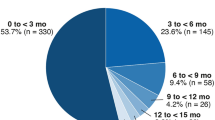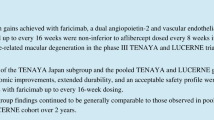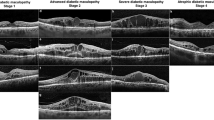Abstract
Purpose
To evaluate visual outcomes in combination therapy with photodynamic therapy (PDT) and intravitreal triamcinolone acetonide (IVTA) for subfoveal choroidal neovascularization (CNV) from age-related macular degeneration (AMD).
Methods
Charts of 39 eyes from 38 patients with exudative AMD treated with PDT and 4 mg of triamcinolone acetate injected intravitreally were reviewed retrospectively. Visual data, angiographic lesion type, prior PDT exposure, number of treatments, and follow-up were recorded. Snellen visual acuities were converted to LogMAR for all calculations. Lines of vision lost or gained pertain to calculated ETDRS lines of vision (via LogMAR).
Results
Twenty-two of the choroidal neovascular membranes were occult, and 17 were classified as predominantly classic. Mean follow-up was 43 weeks. The average number of treatments was 2.23. At final follow-up, 11 eyes (28.21%) experienced improved visual acuity, 8 eyes (20.51%) were stable, and 20 eyes (51.28%) had worsened. No significant difference in treatment response was found between angiographic subtypes (p > 0.59). Lack of previous PDT exposure did not improve treatment outcomes (p > 0.77). Pre-treatment visual acuity (PTVA) was determined as a strong predictor of treatment outcome in our study cohort. Visual acuity of 20/200 or worse was associated with a 40.9% chance of some improvement and a 35.75% chance of three or more lines of improvement. Visual acuity better than 20/200 was associated with an 89.4% chance of no improvement and a 58.8% chance of three or more lines of visual loss.
Conclusion
Counter to previously reported results with combination therapy, the majority of our patients (72%) did not demonstrate improved vision and 51% lost vision. When PTVA was accounted for, selected patients benefitted significantly from treatment. PTVA may be a useful and simple patient selection tool for combination treatment with PDT and IVTA.







Similar content being viewed by others
References
Smith W, Assink J et al (2001) Risk factors for age-related macular degeneration: Pooled findings from three continents. Ophthalmology 108(4):697–704
Macular Photocoagulation Study Group (1991) Subfoveal neovascular lesions in age-related macular degeneration: guidelines for evaluation and treatment in the macular photocoagulation study. Arch Ophthalmol 109:1242–1257
Pauleikhoff D, Bornfeld N et al (2005) Konsenspapier der Retinologischen Gesellschaft, der Deutschen Ophthalmologischen Gesellschaft und des Berufsverbandes der Augenarzte-Stellungnahme zur aktuellen Therapie der neovaskularen AMD. Klinische Monatsblatter fur Augenheilkunde 222(5):381–388
Chakravarthy U, Soubrane G et al (2006) Evolving European guidance on the medical management of neovascular age related macular degeneration. Br J Ophthalmol 90(9):1188–1196
Rosenfeld PJ, Rich RM, Lalwani GA (2006) Ranibizumab: Phase III clinical trial results. Ophthalmol Clin North Am 19(3):361–372
Brown DM, Kaiser PK, Michels M, Soubrane G, Heier JS, Kim RY, Sy JP, Schneider S, ANCHOR Study Group (2006) Ranibizumab versus verteporfin for neovascular age-related macular degeneration. N Engl J Med 355(14):1432–1444
Bressler NM (2001) Treatment of age-related macular degeneration with photodynamic therapy study. Photodynamic therapy of subfoveal choroidal neovascularization in age-related macular degeneration with verteporfin: two-year results of 2 randomized clinical trials-tap report 2. Arch Ophthalmol 119(2):198–207
Verteporfin In Photodynamic Therapy Study Group (2001) Verteporfin therapy of subfoveal choroidal neovascularization in age-related macular degeneration: two-year results of a randomized clinical trial including lesions with occult with no classic choroidal neovascularization–verteporfin in photodynamic therapy report 2. Am J Ophthalmol 131(5):541–560
Bressler NM (2002) Verteporfin therapy of subfoveal choroidal neovascularization in age-related macular degeneration: two-year results of a randomized clinical trial including lesions with occult with no classic choroidal neovascularization-verteporfin in photodynamic therapy report 2. Am J Ophthalmol 133(1):168–169
Bressler NM et al; Treatment of Age-Related Macular Degeneration with Photodynamic Therapy (TAP) Study Group (2002) Verteporfin therapy of subfoveal choroidal neovascularization in patients with age-related macular degeneration: additional information regarding baseline lesion composition’s impact on vision outcomes-TAP report no. 3. Arch Ophthalmol 120(11):1443–1454
Augustin AJ, Schmidt-Erfurth U (2006) Verteporfin therapy combined with intravitreal triamcinolone in all types of choroidal neovascularization due to age-related macular degeneration. Ophthalmology 113(1):14–22
Augustin AJ, Schmidt-Erfurth U (2006) Verteporfin and intravitreal triamcinolone acetonide combination therapy for occult choroidal neovascularization in age-related macular degeneration. Am J Ophthalmol 141(4):638–645
Spaide RF, Sorenson J et al (2003) Combined photodynamic therapy with verteporfin and intravitreal triamcinolone acetonide for choroidal neovascularization. Ophthalmology 110(8):1517–1525
Spaide RF, Sorenson J et al (2005) Photodynamic therapy with verteporfin combined with intravitreal injection of triamcinolone acetonide for choroidal neovascularization. Ophthalmology 112(2):301–304
Nicolo M, Ghiglione D et al (2006) Occult with no classic choroidal neovascularization secondary to age-related macular degeneration treated by intravitreal triamcinolone and photodynamic therapy with verteporfin. Retina 26(1):58–64
Spaide RF, Sorenson J et al (2005) Combined photodynamic therapy and intravitreal triamcinolone for nonsubfoveal choroidal neovascularization. Retina 25(6):685–690
Chan WM, Lai TY et al (2006) Combined photodynamic therapy and intravitreal triamcinolone injection for the treatment of subfoveal choroidal neovascularisation in age related macular degeneration: a comparative study. Br J Ophthalmol 90(3):337–341
Ergun E, Maar N et al (2006) Photodynamic therapy with verteporfin and intravitreal triamcinolone acetonide in the treatment of neovascular age-related macular degeneration. Am J Ophthalmol 142(1):10–16
Holladay JT (1997) Proper method for calculating average visual acuity. J Refract Surg 13:388–391
Blyth CR, Still HA (1983) Binomial confidence intervals. J Am Stat Assoc 78:108–116
Author information
Authors and Affiliations
Corresponding author
Rights and permissions
About this article
Cite this article
Schadlu, R., Kymes, S.M. & Apte, R.S. Combined photodynamic therapy and intravitreal triamcinolone for neovascular age-related macular degeneration: effect of initial visual acuity on treatment response. Graefes Arch Clin Exp Ophthalmol 245, 1667–1672 (2007). https://doi.org/10.1007/s00417-007-0619-0
Received:
Revised:
Accepted:
Published:
Issue Date:
DOI: https://doi.org/10.1007/s00417-007-0619-0




